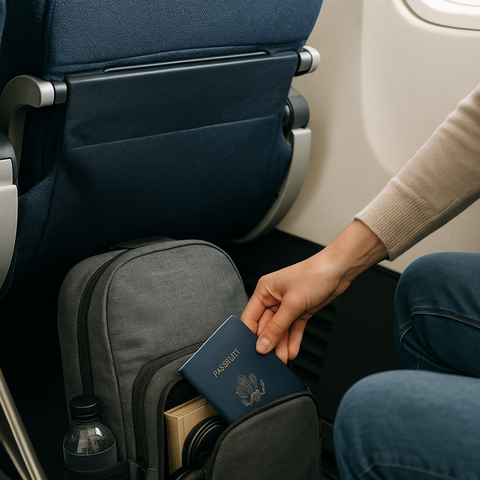
The Bag Frequent Flyers Always Pack First
Most travelers don’t think much about the space under the seat in front of them until the flight is underway and the only bag they can access is the one down there.
That bag, officially called a personal item, is the one piece of luggage airlines allow you to keep by your side throughout the journey. It isn’t a handbag or a pocket. It’s a small, structured bag meant to hold your essentials in-flight.
Despite its importance, most people underestimate it. They plan for the destination but not the hours in transit. They check weather forecasts but forget about delays. They focus on outfits but overlook the charger, medication, or snack they might need at 30,000 feet.
Airlines define personal items by size, not by contents. United allows bags up to 17 x 10 x 9 inches. JetBlue permits 17 x 13 x 8. Southwest allows 18.5 x 13.5 x 8.5. Most carriers set a limit between 36 and 40 linear inches, calculated as length plus width plus height.
These are not estimates. They’re measured. Gate agents may inspect your bag even if you’ve flown with it before. What passed last month might get flagged today. Your only insurance is accuracy: measure the bag when it’s fully packed, not empty. A bag that looks compact can expand once filled.
Carry-ons get most of the attention. They hold your clothes, they roll beside you, they dominate packing checklists. But once you’re in your seat, they’re out of reach.
The personal item bag is different. It stays at your feet. It holds the items you’ll reach for without standing. That includes your passport, phone, charger, earphones, medication, hand sanitizer, documents, snacks, and anything else you’ll want on hand during the flight.
If that bag fails, if it’s too bulky, poorly packed, or disorganized, you’ll feel it the moment you’re stuck in turbulence or on the runway with no overhead access.
Not every small bag qualifies. Many expand too much once filled. Others lose structure and sag past the point of approval.
The most reliable bags tend to fall into a few categories: slim backpacks, compact totes, and brief-style crossbodies. Look for these features:
-
Defined structure that holds its shape
-
Low-profile straps and handles that don’t add bulk
-
Separate compartments to organize contents
-
Padded sleeves for laptops or tablets
-
Fully closing zippers
-
Water-resistant materials
A good personal item bag isn’t about fashion. It’s about fit, access, and function. It should slide easily under the seat without needing a shove and stay stable through the flight.
The personal item bag isn’t meant for overflow. It’s meant for function. Everything in it should serve a clear purpose during the flight.
Pack:
-
Travel documents: Passport, ID, boarding pass (digital copies too)
-
Electronics: Phone, charger, power bank (must stay with you)
-
Health: Medication, hand sanitizer, tissues, face mask
-
Comfort: Lip balm, lotion, eye mask, earphones, snacks
-
Utilities: Pen, book or tablet, empty water bottle (fill after security)
Liquids must be under 100 ml. Keep them accessible for screening. Cables and chargers should be separated for easy retrieval. Never pack batteries, valuables, or fragile electronics in checked luggage. Most airlines prohibit it.
A well-organized personal item bag reduces stress everywhere else. You don’t need to overpack your carry-on. You avoid digging into the overhead bin during the flight. You skip last-minute repacking when a gate agent asks you to consolidate.
For short trips, some travelers skip the carry-on altogether. A compact, well-packed personal item bag can carry everything they need for two days of work or leisure.
Fewer bags mean faster boarding, fewer delays, and fewer points of failure.
Don’t wait until the airport to find out your bag doesn’t qualify. Do this instead:
-
Measure the bag fully packed
-
Weigh it if your airline has weight restrictions
-
Check the current personal item size rules on your airline’s website
-
Confirm dimensions in inches or centimeters, depending on your location
Preparation takes minutes. Fixing mistakes at the gate can cost you the entire boarding window.
The personal item bag isn’t extra. It’s essential. In a cabin where space is limited and time is inflexible, this is the only luggage you control from start to finish.
Pack it with intent. Keep it close. And when the seatbelt clicks and the aisle disappears, it will carry everything that matters, right at your feet.
Rare Klub bags blend style, comfort, and durability. Designed for work, everyday life, special occasions, and casual outings, they fit seamlessly into any moment. Easy to carry and built to last, our exotic collection brings sophistication and practicality to everything you do. From backpacks and totes to duffels, carry-ons, evening bags, work bags, and more, each piece is thoughtfully crafted to complement your style. With Rare Klub, elegance feels effortless.

Comments (0)
There are no comments for this article. Be the first one to leave a message!